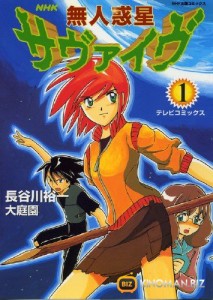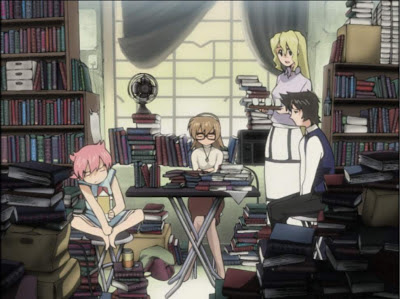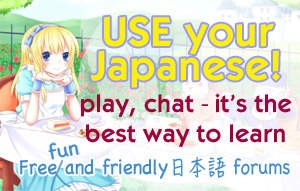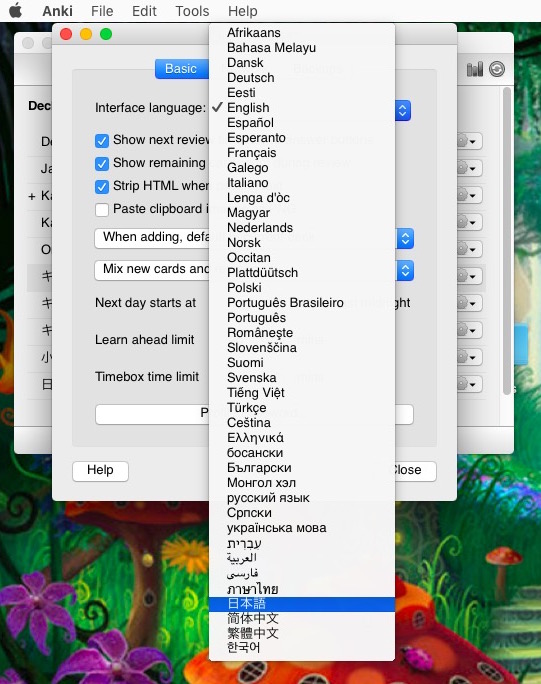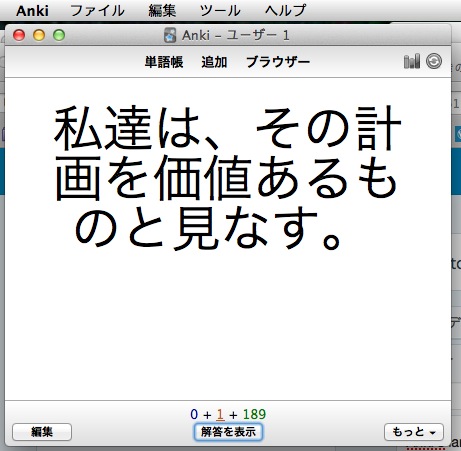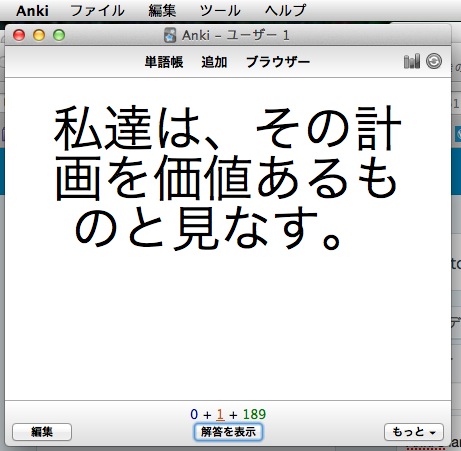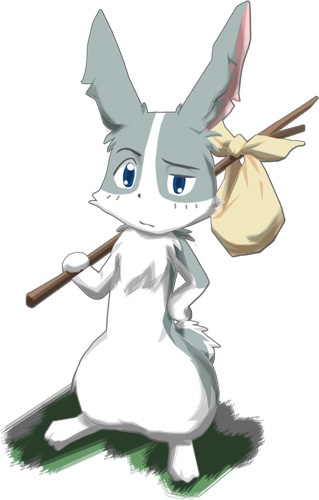There comes a time when one has to start thinking about retiring the Japanese-English dictionary.
How and when one does this has been a matter of some discussion among the Japanese learning community. Some extreme immersionists (indirect immersionists as I call them) recommend doing it quite early on. This tends to go hand in hand with the 10,000 sentences method, which I have never used, though I do have my own sentences method, but it is not central to my method and I am increasingly trying to use massive input to contextualize and naturalize words.
The argument for making a “cold turkey” switch to pure J-J definitions is that it makes one think in Japanese, and define words in Japanese terms rather than referring it back to English all the time. The problem with it is that at first it is very difficult and time consuming. It involves “branching”, which means that looking up one word may lead to a definition in which one does not know three more words. Each of these words may do the same. So looking up one word can “branch” into learning 50 words or more.
The reasons I have not done this are partly my own and partly common to a lot of other people who haven’t, I suspect. They are:
1. I learn words on the fly, while watching anime, reading etc. This is already quite a disruption but it works for me (I am not the kind of organized person who can put words aside for later). Going into a massive branching session that could take the rest of the day just wouldn’t work with the way I do things.
2. Relatedly, my way of going about things involves minimal “study”. As I am always saying, one should use Japanese, not “learn” or “practice” it. Now in a sense, all that branching is using Japanese. One is using it in the way a Japanese child uses it when she looks something up. She can’t go to another language. On the other hand she never encounters 50-deep ramifications. My technique has been to spend one’s time living in Japanese, not buried in reference books. I “do Anki” but that is the major part of my “pure study”. Branching would change the balance completely. I am not saying I shouldn’t do it, but it would be quite a change of approach.
3. I have very poor short-term memory. I have never been able to do simple math because by the time I have done the smallest sub-calculation I have forgotten the main calculation. I have a very difficult time putting details together. Therefore I suspect I would get into a hopeless tangle pretty quickly.
Now, having said all this, I am also an extreme immersionist and my aim is to make Japanese my language. So for me, and all of you who are dedicated to Japanese and in this for the long haul, the question is not whether we switch to all-Japanese and the use of Japanese-Japanese dictionaries etc. The question is simply when we do it.
For me, Japanese is my language. English is just a foreign language I happen to know. I certainly do not intend to be looking up words via some foreign language all my life, any more than I intend to be using Anki all my life.
If any of this resonates with you, then we all have the same question:
When and how do we make the change?
Currently I am in what I regard as a bridging stage, and I would like to share some of the techniques I am currently using to ease the transition to J-J and stop it turning into a monster.
Sanseido? Sansei!
Use a simple dictionary. If you are using an online one I recommend the Sanseido dictionary. It has brief and simple definitions.
Are simple definitions sufficient? Well it seems to me that the heart of the J-J method as we see it is to learn to experience the Japanese word in and for itself (rather than attaching it to the nearest-equivalent English word). For this purpose dictionaries are really only a crutch. One actually learns the word by seeing it in action. Preferably repeatedly and in different contexts. This is the only way you can learn the weight, color and tone of a word. No dictionary can give you that information.
The purpose of the dictionary is that of the mounting-block that helps you get your foot in the stirrup. The dictionary can’t ride the horse for you. What you need is enough information to get a preliminary grip on the word. Sanseido will give you this most of the time.
Another important value of Sanseido is that it is supported by Rikaisama. What this means is that you can go to the Sanseido dictionary online, enter the words you want, and if there are unknown words in the definition, then you can use Rikaisama to get Sansiedo’s definitions of those words without opening new tabs.
2018 update -this situation has changed somewhat.However the method is still applicable. See this article.
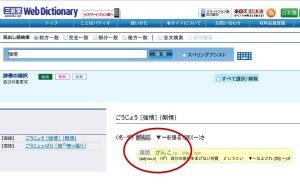
I have heard people talk about having 50 tabs open pursuing the trail of one word. I know that I can’t possibly juggle layers of information in that way. I may be the only one with that disability, but I suspect I am not.
With the method I am suggesting, if the definitions of definitions contain unknown words you can choose whether to open a fresh Sanseido tab and whether, and at what stage, to take a Gordian-knot-cutting peek.
I will do this sometimes, because essentially what I am doing is watching an anime or reading a book. This dictionary business is all peripheral, and my aim is to learn the words by meeting them.
But I also want to understand them as Japanese words/concepts, not as stand-ins for English words/concepts.
So here are some compromise suggestions:
1. If you get an English definition, make it at the second level at least. In other words, what goes into your Anki is a Japanese definition even if you “cheated” a bit to understand it. You will only do that once. Thereafter the definition you learn and are tested on is Japanese. You will be hearing that Japanese definition for a while to come. The English “leg up” will quickly fade but the Japanese definition will stay with you.
2. Yes I did say “hearing”. This is a matter of personal style, but I like to use Kyoko to have the definitions in audio on the back of my cards. I seem to be quite largely an audial learner, so on the front of the card I have the word in kanji. On the back the pronunciation of the word, and its Japanese definition are written and reinforced aurally. This is another reason to prefer succinct definitions.
Update – The audio situation has changed and improved a lot since this article was written. Find out how to add native audio word pronunciations to Anki with the same single keypress that makes the whole card for you!
I used to find that I often unconsciously remembered pretty much the exact words of a definition in English (even though I didn’t use audio for them). Why waste that surplus memory function by stuffing yet more English into the mind when it could be Japanese?
3. Exceptions. There are a few cases where you may want to give a word an “English pass”. If you really can’t understand a Japanese definition you can decide that you are not yet “old enough” in Japanese to know the word. You can also simply use the English definition. You don’t have to transition all at once. One of the cures here is currently at 25% J-J. I am probably just reaching around 75%.
There are also special cases where you may want to think about making an exception for a while. Two possible cases for this are:
a) Very abstract words. I have a hard time with these in English. It may be worth using English definitions until you have enough grasp of abstract Japanese words to use them in defining other abstract words.
b) New kanji. If you are using our approach of learning words, not kanji, you will encounter new kanji from time to time. In these cases, I tend to write a little story around the kanji elements to glue the kanji in place in my mind. This all goes onto the same card as the word definition (later I will tend to think of the kanji as 〜の漢字, 〜 being the word I first learned it in, or the one that has since become most prominent in my mind and seems to represent the kanji’s essence). I think it is legitimate to write the kanji-structure story in English if you need to, though increasingly I do it in Japanese. Which brings us to:
4. Mnemonics. Do you use mnemonics? Not everyone needs them. Frankly, while I have a better than average English vocabulary I am hopeless with new words unless I know their etymology. I can have trouble calling to mind the names of friends I meet online regularly. Therefore I pretty much need, in many cases, to give myself a handle to grasp a word by, that links its kanji, pronunciation and meaning. I write these on the back of cards because that’s the way my mind works. I sometimes need that extra reminder two or three times. Then it usually sticks.
But, and I believe this is important, If you are at the stage where you can even think of dabbling in J-J definitions, you can make your mnemonics in Japanese.
This is connected with the wider question of making Japanese your default language. You may not want to do it wholly as I do, but you certainly must do it in the “Japanese zones” of your life.
So don’t be one of those people who, the minute they aren’t actually buried in a dictionary naturally make their mnemonics in “real language”. For you, Japanese is real language. Why would you make mnemonics in a foreign language just because you happen to know it better?
Even if you have to borrow a foreign word for your mnemonic, frame the story in Japanese. Here is an example:
だだ 1 駄々]
甘えてわがままをいうこと. ▼~をこねる
甘えん坊の「dada」の娘。
無駄でダメ!
This is Sanseido’s definition of 駄々, conveniently exported from Rikaisama to Anki with a single keypress. I add mnemonic notes in red. Here I have used English baby-talk “dada” (=父親)to link the sound to its meaning, but the mnemonic is in Japanese. I also remind myself that the repeated kanji is the だ of both ダメ(駄目)and 無駄.
It is best, though to use J-J mnemonics wherever possible. This can seem a little strange in that you will be using Japanese words in punning ways not connected with their real meaning. Is this confusing? I have to say I have never once found it confusing. It reinforces the word used as well as the word being “learned” and deepens one’s friendship with the familiar word. You have shared a little joke together.
And making friends with words is really the crux of all this. The dictionary and Anki parts are not the process. The process starts where they end. Of course you can be making friends with a word while it is still current in your Anki, but Anki isn’t where true friendship is made. True friendship is made through living, loving, laughing, hoping, fearing and experiencing together. This is why we always talk about using Japanese, not just practicing it.
The dictionary is where you are formally introduced to a word and both say a nervous hajimemashite. Anki is where you see it on the bus sometimes and learn to recognize its face. None of this has much to do with making friends. I suppose that is part of the reason I am disinclined. to get too tied up in dictionary-based work.
Having Anki’s interface itself in Japanese is important here too, I believe. This goes deeper than just J-J definitions. It is also a question of whether you are seeing Japanese as a “foreign language” that you work with through the medium of “real language”, or whether you see Japanese as real language so that everything that is “meta” to your anime or your learning is naturally in Japanese. Because what other language is there?
There is that funny foreign English that some level of my mind seems to know quite well. It can be useful at times, but the moment it has served its purpose, obviously I revert to Real Language.
